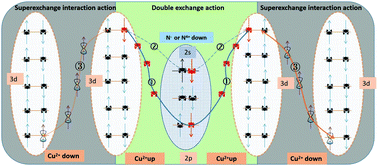当前位置:
X-MOL 学术
›
Phys. Chem. Chem. Phys.
›
论文详情
Our official English website, www.x-mol.net, welcomes your feedback! (Note: you will need to create a separate account there.)
Influence of the type of carrier on ferromagnetism in a Si semiconductor implanted with Cu ions
Physical Chemistry Chemical Physics ( IF 3.3 ) Pub Date : 2020/03/09 , DOI: 10.1039/c9cp05608d Li Wang 1, 2, 3, 4, 5 , Denglu Hou 4, 5, 6, 7, 8 , Chunfang Wu 4, 5, 6, 7, 8 , Yuanping Shi 1, 2, 3, 4, 5 , Shaohui Shi 1, 2, 3, 4, 5 , Weikun Gao 1, 2, 3, 4, 5 , Shunzhen Feng 1, 2, 3, 4, 5 , Yingdi Liu 1, 2, 3, 4, 5 , Li Li 1, 2, 3, 4, 5 , Denghui Ji 1, 2, 3, 4, 5
Physical Chemistry Chemical Physics ( IF 3.3 ) Pub Date : 2020/03/09 , DOI: 10.1039/c9cp05608d Li Wang 1, 2, 3, 4, 5 , Denglu Hou 4, 5, 6, 7, 8 , Chunfang Wu 4, 5, 6, 7, 8 , Yuanping Shi 1, 2, 3, 4, 5 , Shaohui Shi 1, 2, 3, 4, 5 , Weikun Gao 1, 2, 3, 4, 5 , Shunzhen Feng 1, 2, 3, 4, 5 , Yingdi Liu 1, 2, 3, 4, 5 , Li Li 1, 2, 3, 4, 5 , Denghui Ji 1, 2, 3, 4, 5
Affiliation

|
Silicon semiconductor samples implanted with Cu ions and samples co-implanted with Cu- and N-ions were prepared by MEVVA and the Kaufman technique. None of the samples showed evidence of secondary phases. The initially n-type Si matrix, when implanted with Cu ions, changed to a p-type semiconductor, and the Cu ions existed as local Cu2+ cations in the p-type environment. As a result, none of the Cu-implanted samples were ferromagnetic at room temperature. The co-implanted samples, on the other hand, showed room-temperature ferromagnetism because the introduction of N ions made the carrier type change from p-type to n-type which is favorable for the appearance of Cu2+. First principles calculations were applied to understand the experimental phenomena. The formation energy was reduced by implanting N ions, and was decreased effectively with the increase in ratio of N to Cu ions. The density of states and spin density of states indicated that the hybridization of s, p and d electrons induced ferromagnetism at 0 K. Particularly, we proposed possible exchange interactions between the Cu2+–N−(N4+)–Cu2+ ions to explain the ferromagnetism mechanism.
中文翻译:

载流子类型对注入铜离子的硅半导体中铁磁性的影响
通过MEVVA和Kaufman技术制备了注入有铜离子的硅半导体样品以及共注入有铜和N离子的样品。没有样品显示出第二相的证据。最初的n型Si基体在注入Cu离子后变为p型半导体,并且Cu离子在p型环境中作为局部Cu 2+阳离子存在。结果,Cu注入的样品在室温下都不是铁磁性的。另一方面,共注入样品显示出室温铁磁性,因为引入N离子使载流子类型从p型变为n型,有利于Cu 2+的出现。。应用第一原理计算来理解实验现象。注入N离子可降低形成能,并随着N与Cu离子比的增加而有效降低。国家和国家自旋密度的密度表明,S,P和d电子诱导铁磁性的,在0 K.杂交特别是,我们提出将Cu之间的可能的交换相互作用2+ -N -(N 4+)-Cu 2+离子来解释铁磁性机理。
更新日期:2020-04-15
中文翻译:

载流子类型对注入铜离子的硅半导体中铁磁性的影响
通过MEVVA和Kaufman技术制备了注入有铜离子的硅半导体样品以及共注入有铜和N离子的样品。没有样品显示出第二相的证据。最初的n型Si基体在注入Cu离子后变为p型半导体,并且Cu离子在p型环境中作为局部Cu 2+阳离子存在。结果,Cu注入的样品在室温下都不是铁磁性的。另一方面,共注入样品显示出室温铁磁性,因为引入N离子使载流子类型从p型变为n型,有利于Cu 2+的出现。。应用第一原理计算来理解实验现象。注入N离子可降低形成能,并随着N与Cu离子比的增加而有效降低。国家和国家自旋密度的密度表明,S,P和d电子诱导铁磁性的,在0 K.杂交特别是,我们提出将Cu之间的可能的交换相互作用2+ -N -(N 4+)-Cu 2+离子来解释铁磁性机理。



























 京公网安备 11010802027423号
京公网安备 11010802027423号